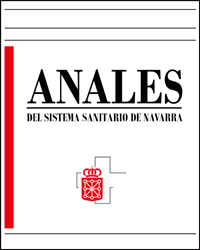Síndrome nefrótico secundario en neurofibromatosis tipo 1. A propósito de dos casos
DOI:
https://doi.org/10.23938/ASSN.0720Palabras clave:
Neurofibromatosis tipo 1. Enfermedad de cambios mínimos. Amiloidosis secundaria. Síndrome nefrótico.Resumen
La Neurofibromatosis tipo I (NF-1) es un desorden neurocutáneo, con clínica multisistémica de tipo autosómica dominante de diagnóstico clínico. Hay escasas publicaciones sobre la afectación rwnal de esta enfermedad, siendo la patología vascular renal y los tumores suprarrenales, la forma de afectación renal más frecuente, y excepcional los casos descritos de afectación glomerular.
Presentamos dos casos de síndrome nefrótico en pacientes con diagnóstico de NF-1. El primer caso, la paciente es una mujer de 41 años, diagnosticada de NF-1 durante el estudio de un síndrome nefrótico córtico-resistente, con diagnóstico de cambios mínimos. El segundo caso es una mujer de 71 años con antecedente de NF-1, con un síndrome nefrótico y una amiloidosis renal secundaria.
A pesar de la escasez de información publicada actualmente sobre ello, se ha sugerido una posible asociación entre la NF-1 y el síndrome nefrótico, debida a mecanismos moleculares comunes en ambas patologías. Destacamos la importancia de estudiar un origen primario tratable del síndrome nefrótico.
Descargas
Citas
JETT K, FRIEDMAN JM. Clinical and genetic aspects of Neurofibromatosis. Genet Med 2010; 12: 1-11. https://doi.org/10.1097/GIM.0b013e3181bf15e3
UEDA K, AWAZU M, KONISHI Y. Persistent hypertension despite successful dilation of a stenotic renal artery in a boy with neurofibromatosis type 1. Am J Med Genet A 2013; 161A: 1154-1157. https://doi.org/10.1002/ajmg.a.35829
DUAN L, FENG K, TONG A. Renal artery stenosis due to neurofibromatosis type 1: case report and literature review. Eur J Med Res 2014; 19: 1. https://doi.org/10.1186/2047-783X-19-17.
FRANZ DN, WEISS BD. Molecular therapies for tuberous sclerosis and neurofibromatosis. Curr Neurol Neurosci Rep 2012; 12: 294-301. https://doi.org/10.1007/s11910-012-0269-4
SHIBATA T, KUDOH K, ISHII T. A case of membranous nephropathy associated with von Recklinghausen’s disease. Kidney Dial 1990; 29: 145-148.
DE CARIDI G, MASSARA M, SPINELLI F. Uncommon case of symptomatic left renal vein compression caused by neurofibroma. Asian Cardiovasc Thorac Ann 2016; 24: 492. https://doi.org/10.1177/0218492315573675
GUI X, ZHENG Y. Renal artery aneurysm at the hilum secondary to neurofibromatosis type I. Eur J Vasc Endovasc Surg 2015; 49: 464. https://doi.org/10.1016/j.ejvs.2015.01.022
GERSCH, M. S, TALOR, Z. Focal segmental glomerular sclerosis in a patient with neurofibromatosis type I. Am J Kidney Dis 2006; 47: 17-19. https://doi.org/10.1053/j.ajkd.2005.09.017
TOTH T, TRINN C, SIMON L, NAGY J. A case of membranous glomerulonephritis associated with Recklinghausen’s neurofibromatosis. Clin Nephrol 1996; 4: 271-272 .
KOKUBO T, HIKI Y, HORII A, KOBAYASHI Y. RECKLINGHAUSEN’S neurofibromatosis associated with membranous nephropathy. Nephron 1993; 6: 486. https://doi.org/10.1159/000187543
TANIGUCHI Y, YORIOKA N, KANBE M, OKUSHIN S, ODA H, NISHIDA Y et al. Parent and child cases of IgA nephropathy associated with von Recklinghausen’s disease. Nephron 1997; 75: 113-114. https://doi.org/10.1159/000189515
HYUN JI, MIN JW, LEE HM. Minimal changes nephrotic syndrome showing complete remission after resection of a neurofibroma in a type I neurofibromatosis patient. Korean J Intern Med 2017; 32: 186-189. https://doi.org/10.3904/kjim.2015.016
VIVARELLI M, MASELLA L, RUGGIERO B. Minimal Change Disease. Clin J Am Soc Nephrol 2017; 12: 332-345.
GLASSOCK RJ. Secondary minimal changes disease. Nephrol Dial Transplant 2003; 18: 52-58.
DOGAN A. Classification of amyloidosis by mass spectometry-based proteomics. En: Amyloid and related disorders. Surgical Pathology and clinical correlations. Pickens MM , Dogan A; Herrera GA. Cham: Humana Press, 2012: 261-272. https://doi.org/10.1007/978-1-60761-389-3_21
HSUEH YP, ROBERTS AM, VOLTA M. Bipartite Interaction between neurofibromatosis type I protein (neurofibromin) and syndecan transmembrane heparan sulfate proteoglycans. J Neurosci 2001; 21: 3764–3770. https://doi.org/10.1523/jneurosci.21-11-03764.2001
DE SCHEPPER S, BOUCNEAU J, WESTBROEK W, MOMMAAS M, ONDERWATER J, MESSIAEN L et al. Neurofibromatosis type 1 protein and amyloid precursor protein interact in normal human melanocytes and colocalize with melanosomes. J Invest Dermatol 2006; 126: 653-659. https://doi.org/10.1038/sj.jid.5700087
ABRAMOWICZ A, GOS M. Neurofibromin in neurofibromatosis type 1- mutations in NF1 genes as a cause of disease. Dev Period Med 2014; 18: 297-306.
AFSHINNIA F, VEGA-WARNER V, KILLEN P. Focal segmental glomerulosclerosis in association with neurofibromatosis type 1: a case report and proposed molecular pathways. Clin Kidney J 6, 2013: 208-210. https://doi.org/10.1093/ckj/sft010
GODEL M, HARTLEBEN B, HERBACH N, LIU S, ZSCHIEDRICH S, LU S et al. Role of mTOR in podocyte function and diabetic nephropathy in humans and mice. J Clin Invest 2011; 121: 2197-2209. https://doi.org/10.1172/jci44774
ITO N. mTOR activation triggers the unfolded protein response in pododyctes and leads to nephrotic syndrome. Lab Invest 2011; 91: 1584-1595. https://doi.org/10.1038/labinvest.2011.135
Publicado
Cómo citar
Número
Sección
Licencia
Derechos de autor 2019 Anales del Sistema Sanitario de Navarra

Esta obra está bajo una licencia internacional Creative Commons Atribución-CompartirIgual 4.0.
La revista Anales del Sistema Sanitario de Navarra es publicada por el Departamento de Salud del Gobierno de Navarra (España), quien conserva los derechos patrimoniales (copyright ) sobre el artículo publicado y favorece y permite la difusión del mismo bajo licencia Creative Commons Reconocimiento-CompartirIgual 4.0 Internacional (CC BY-SA 4.0). Esta licencia permite copiar, usar, difundir, transmitir y exponer públicamente el artículo, siempre que siempre que se cite la autoría y la publicación inicial en Anales del Sistema Sanitario de Navarra, y se distinga la existencia de esta licencia de uso.








